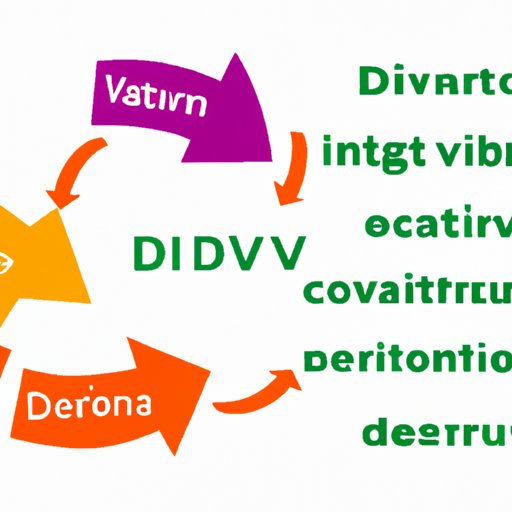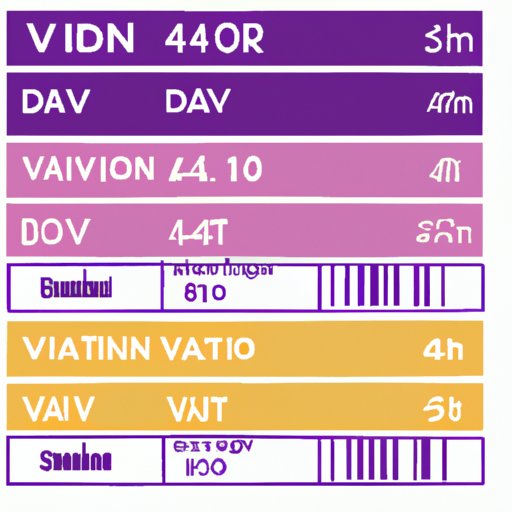Introduction
DV stands for “Daily Value” and is used to indicate the recommended daily amount of a nutrient. In nutrition, it is an important metric that helps people understand how much of a particular nutrient they should be consuming each day. This article will explore what does DV stand for in nutrition and provide a comprehensive guide to understanding the meaning of DV in nutrition.
Exploring the Meaning of DV: What Does DV Stand for in Nutrition?
The term “Daily Value” or “DV” is used to indicate the recommended daily amount of a particular nutrient. The DV is based on the Dietary Reference Intakes (DRIs) developed by the Institute of Medicine of the National Academy of Sciences. The DRIs are designed to provide guidance on the amount of nutrients needed to maintain health and prevent chronic disease. The DRI values are used to calculate the Daily Values which are printed on food labels to help consumers make informed decisions about their dietary choices.

A Comprehensive Guide to Understanding DV in Nutrition
When looking at the nutrition facts label on a food product, the DV is indicated as a percentage of the total recommended daily intake of a particular nutrient. For example, if the label states that the DV for vitamin C is 50%, this means that one serving of the food contains half the recommended daily amount of vitamin C. By knowing the DV for a nutrient, it can help you determine if a food is high or low in that nutrient.
In addition to providing information on the total amount of a nutrient in a food, the DV also helps to identify how much of a particular nutrient is in a single serving. This information is especially useful when comparing different foods. For example, if two foods contain the same amount of calories but one has a higher DV for protein, then it would be the better choice for someone trying to increase their protein intake.
It is important to remember that the DVs are based on average adult requirements, so they may not be appropriate for everyone. For example, pregnant women and children need more of certain vitamins and minerals than adults. Therefore, it is important to talk to a healthcare provider before making any changes to your diet.
In addition, the DV is based on a 2,000-calorie diet. For those who eat more or less than this amount, the DV may not be an accurate measure of their nutrient needs. For example, if someone consumes 1,500 calories per day, their DV for certain nutrients may be lower than the DV listed on the label.
How to Calculate DV in Nutrition
To calculate the DV for a nutrient, first look at the percent daily value (%DV) listed on the nutrition label. This figure is based on the DRI for that nutrient. To find the DV, multiply the %DV by the total number of calories in a serving. For example, if the %DV for calcium is 10% and a serving of the food contains 100 calories, then the DV for calcium would be 10 calories (10% x 100 calories = 10 calories).
Factors that Affect DV
There are several factors that can affect the DV of a nutrient. For example, the type of food being consumed can have an impact on the DV. For example, fortified foods such as breakfast cereals often have higher levels of certain vitamins and minerals than other types of food. Additionally, the processing of food can also affect the DV. For instance, some foods may lose some of their nutritional value during processing.
Benefits of Knowing Your Daily Value
Knowing your daily value for certain nutrients can be beneficial in several ways. First, it can help you make informed decisions about what foods to include in your diet. By knowing which foods are higher in certain nutrients, you can make sure that you are getting enough of them in your diet. Additionally, knowing your daily value can help you track your progress toward meeting your nutrient goals. This can be especially helpful for those who are trying to maintain a healthy weight or improve their overall health.

Uncovering the Significance of DV in Nutrition
Understanding the meaning of DV in nutrition is important for a number of reasons. First, it can help you make informed decisions about what foods to include in your diet. Additionally, it can give you a better understanding of the nutritional content of foods. Finally, it can help you track your progress toward meeting your nutritional goals.
Why is it Important to Know Your DV?
Knowing your DV is important because it can help you make informed decisions when it comes to choosing the best foods for your diet. Additionally, it can help you monitor your progress toward meeting your nutrient goals. According to a study published in The American Journal of Clinical Nutrition, “Consumers who understand the DV can use it to make more informed food choices and better meet their personal nutrient needs.”

The Role of DV in Weight Management
In addition to helping you make informed dietary choices, knowing your DV can also be beneficial for those who are trying to manage their weight. Because the DV is based on the Dietary Reference Intakes (DRIs), it can help you identify which foods are higher in certain nutrients. This can be especially helpful for those who are trying to reduce their calorie intake while still meeting their nutrient needs.
The Basics of DV: What Does DV Stand for in Nutrition?
When looking at the nutrition facts label on a food product, there are several elements that can give you insight into its nutritional content. One of these is the DV, which stands for “Daily Value.” This figure indicates the recommended daily amount of a particular nutrient. It is based on the Dietary Reference Intakes (DRIs) set by the Institute of Medicine of the National Academy of Sciences.
Understanding the Labels
In order to understand what does DV stand for in nutrition, it is important to understand how to read a nutrition facts label. Generally, the label will list the nutrient content of a single serving size of the food. It will also include the DV for each nutrient, which is expressed as a percentage of the total recommended daily intake of that nutrient.
What is Included in a Serving Size?
The serving size listed on the nutrition facts label is based on the amount of food typically consumed in one sitting. It is important to pay attention to this number as it can help you understand how much of a particular nutrient you are consuming. For example, if one serving of a food contains 30% of the DV for calcium, then it means that eating one serving will provide you with 30% of the total recommended daily intake of calcium.
Demystifying DV in Nutrition: What Does DV Mean?
When looking at a nutrition facts label, the DV can be a helpful tool for understanding the nutritional content of a food. It is based on the Dietary Reference Intakes (DRIs) and indicates the recommended daily amount of a particular nutrient. By knowing the DV for a nutrient, you can compare different foods and make informed decisions about what to include in your diet.
Examples of Nutritional Labels
Here are some examples of DV percentages found on a nutrition facts label:
- Calcium: 30%
- Fiber: 25%
- Sodium: 10%
- Vitamin A: 15%
- Vitamin C: 20%
Tips on Reading Nutritional Labels
When reading a nutrition facts label, here are some tips to keep in mind:
- Pay attention to the serving size listed on the label.
- Read the list of ingredients to determine if the food contains added sugars or unhealthy fats.
- Compare the DV of different foods to determine which ones are higher in certain nutrients.
- Remember that the DV is based on a 2,000-calorie diet, so it may not be an accurate measure of your nutrient needs.
Conclusion
In conclusion, it is important to understand what does DV stand for in nutrition. The DV is based on the Dietary Reference Intakes (DRIs) and indicates the recommended daily amount of a particular nutrient. Knowing the DV for a nutrient can help you make informed decisions about what foods to include in your diet, as well as track your progress toward meeting your nutrient goals. By understanding the meaning of DV in nutrition, you can make sure that you are getting enough of the essential nutrients your body needs.
Summary
This article provided a comprehensive guide to understanding the meaning of DV in nutrition. It explored the significance of DV in nutrition and gave tips on reading nutritional labels. The DV is based on the Dietary Reference Intakes (DRIs) and indicates the recommended daily amount of a particular nutrient. Knowing the DV for a nutrient can help you make informed decisions about what foods to include in your diet, as well as track your progress toward meeting your nutrient goals.
Final Thoughts
In order to make the most informed decisions about your diet, it is important to understand what does DV stand for in nutrition. By knowing the DV for a nutrient, you can compare different foods and make sure that you are getting enough of the essential nutrients your body needs. Additionally, it can help you track your progress toward meeting your nutrient goals.
(Note: Is this article not meeting your expectations? Do you have knowledge or insights to share? Unlock new opportunities and expand your reach by joining our authors team. Click Registration to join us and share your expertise with our readers.)
